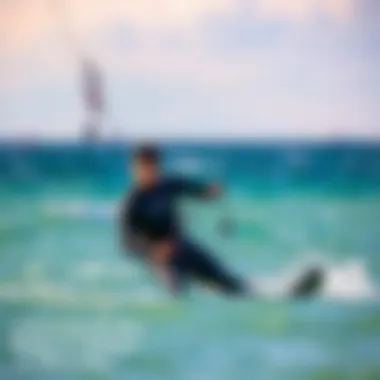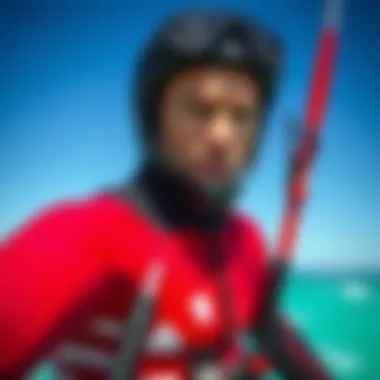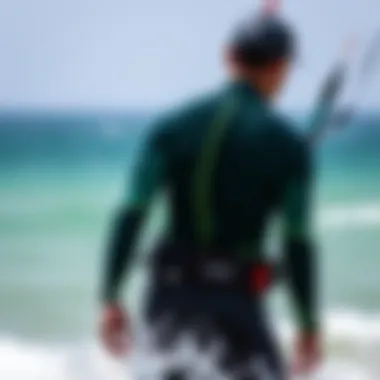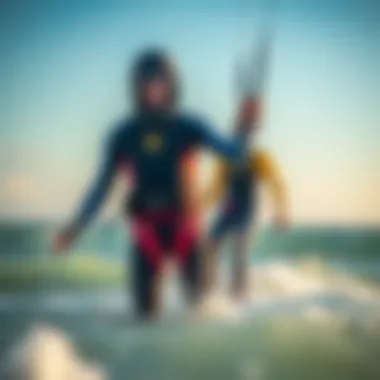Choosing the Right Wetsuits for Kiteboarding


Intro
Selecting the right wetsuit for kiteboarding can make or break your experience on the water. It’s not just about feeling warm; it’s about enhancing performance, ensuring flexibility, and allowing for the freedom of movement that kiteboarding demands. Whether you are a newcomer struggling to stay afloat or a seasoned pro riding the waves with ease, the right wetsuit can be a game changer.
In this guide, we will breakdown various aspects to consider when choosing a wetsuit—materials, fit, and the critical role of design. We’ll also discuss temperature regulation and why it’s essential to get the fit just right. Many kiteboarders overlook these factors, only to find themselves uncomfortable or restricted during their sessions. This article aims to highlight those essentials, helping you to make informed choices that enhance your time on the water.
Let’s dive right into the gear selection, as understanding your equipment is the first step in mastering any sport.
Understanding Wetsuits
Understanding wetsuits is a fundamental aspect when it comes to choosing the right gear for kiteboarding. These specialized garments are designed to keep you warm, provide buoyancy, and allow for a certain level of flexibility. The sea can be as unpredictable as a cat on a hot tin roof, so having the appropriate wetsuit can make the difference between a thrilling ride and a bone-chilling experience.
There are several reasons for a kiteboarder to invest in a good wetsuit. First off, it helps regulate body temperature, especially in colder waters. In addition, wetsuits provide a layer of protection against potential abrasions from the water, any jagged surfaces, or even marine life. Lastly, they can enhance buoyancy, making it easier to stay afloat.
When considering a wetsuit, think about how it fits into your kiteboarding repertoire. Are you mainly hitting the waves in chilly conditions, or are you cruising through warmer waters? Understanding the function and purpose of wetsuits can inform your selection process, ensuring that you are well-equipped for mother nature’s whims.
Purpose of Wetsuits in Kiteboarding
Wetsuits serve multiple purposes for kiteboarders. The most prominent function is thermal insulation. By trapping a thin layer of water between the suit and your skin, wetsuits utilize body heat to keep you warm. When temperatures drop, a quality wetsuit can make those frigid days much more tolerable.
In addition, wetsuits also act as a shield. They protect against wind, which can sap warmth faster than a scream at a ghost. This shield allows riders to maintain longer sessions without succumbing to the cold.
How Wetsuits Function
Wetsuits function primarily through insulation and buoyancy. They are made from synthetic rubber, often called neoprene, which has excellent thermal properties. When you wear a wetsuit, a thin layer of water gets trapped inside, and as your body heats that water, it creates a thermal barrier that helps retain heat.
Beyond insulation, the design of a wetsuit impacts your mobility. A well-fitted wetsuit is snug but not overly restrictive, allowing for natural movement while you ride. This combination of heat retention and flexibility is what makes wetsuits indispensable for kiteboarding.
Types of Wetsuits
Wetsuits come in several types, each designed for specific conditions and preferences in kiteboarding.
Full Suits
Full suits cover the entire body, offering maximum insulation. They are often the go-to choice for kiteboarders braving chilly waters. The key characteristic is their thermal efficiency. A full suit can keep a rider warm even in significantly low temperatures. They usually come in various thicknesses, allowing you to select one based on the specific water conditions. One unique feature of full suits is the added protection from UV rays, which is a significant consideration for frequent riders.
However, full suits can feel a bit cumbersome in warmer water, potentially leading to overheating. Finding the right balance in thickness can mitigate this, but generally, these suits excel in colder climates.
Shorty Suits
Shorty suits, also known as spring suits, provide coverage for the torso and upper arms, making them ideal for warmer conditions. Their key characteristic is a short sleeve and short leg design, which allows for enhanced freedom of movement while still offering some thermal protection. For kiteboarders who find themselves in moderate waters, shorty suits can be a beneficial choice.
One unique feature is the ease of entry and exit, given they don’t cover the legs completely. While they do lack the complete thermal protection of full suits, they compensate with better mobility and breathability, making them a popular option during transitional seasons.
Spring Suits
Spring suits are a thicker variation of the shorty, usually coming in long sleeves but still featuring short legs. They are perfect for spring and autumn kiteboarding, where temperatures can fluctuate. The characteristic feature is that they balance warmth and flexibility effectively.
A spring suit is beneficial for kiteboarders who need a versatile suit that can adapt to changing conditions. The downside, though, is that they might not provide enough warmth for really cold days, which can limit their use in specific environments.


Dry Suits
Dry suits are designed primarily for cold weather conditions. Unlike wetsuits, they do not allow water to enter, keeping the wearer completely dry. The key characteristics of dry suits include their insulation properties and the added layers of protection against harsh weather.
Their unique feature is the ability to wear thermal layers underneath, which allows for customization based on the conditions. Although they are often bulkier and come at a higher price point, dry suits excel in extreme conditions making them a valuable investment for serious kiteboarders. However, they do require more maintenance and care compared to traditional wetsuits, which is something to consider.
Key Features to Consider
When selecting a wetsuit for kiteboarding, understanding the crucial features is like having a compass in uncharted waters. A good wetsuit is not just about style; it significantly influences performance, comfort, and overall enjoyment. Every kiteboarder, whether a newbie or a seasoned pro, should be well-versed in what features are essential to ensure they make an informed choice.
Material Composition
Nep neoprene
Nep neoprene stands out as a popular choice for wetsuits due to its remarkable properties. Its key characteristic lies in its flexibility and insulation. Environmentally conscious kiteboarders might be drawn to its components, as newer neoprene blends often incorporate materials that are safer for the ocean. With a lighter feel and less bulk, Nep neoprene allows for better movement while riding. However, one should also consider the downside; while it tends to be more durable than traditional neoprene, it can wear out faster in extreme conditions.
Eco-friendly alternatives
As the conversation around sustainability heats up, eco-friendly alternatives are becoming more prominent in the wetsuit market. These materials, such as limestone-based neoprene or even plant-based options, aim to reduce the environmental impact. A notable feature of these options is their contribution to decreasing harmful emissions compared to conventional wetsuits. Kiteboarders who prioritize the planet will find these materials not just beneficial but also trendy among today’s conscientious athletes. However, a potential drawback is that some eco-friendly suits may lack the same durability as their synthetic counterparts, requiring more frequent replacement.
Thickness variations
Wetsuit thickness is not a one-size-fits-all matter. The thickness of the suit often dictates warmth and flexibility. For instance, a 3/2mm wetsuit typically provides a good balance for the average kiteboarder, offering adequate insulation while maintaining freedom of movement. Riders in extra cold water can opt for thicker suits, while thinner options, around 2mm, work best in warmer climates. It's imperative to consider that while thicker suits keep you warm, they can be less flexible, which might affect performance when you're out on the water.
Fit and Flexibility
A well-fitting wetsuit allows for a snug but comfortable seal against the body. It can make the difference between fighting the suit or floating freely in the waves. Poor fit translates to cold water seeping in, which can spoil your day real quick. Kiteboarders should prioritize flexibility as a core feature since it enhances movement and prevents restrictions while performing tricks or maneuvers. Always trying on wetsuits before purchasing is wise, as each brand has its sizing nuances.
Seam Construction
Flatlock seams
Flatlock seams are essential for durability in wetsuits, particularly in casual kiteboarding. This type of seam involves stitching panels directly together, which creates a visible line on the outside of the suit. While these seams offer comfort and breathability, they are better suited for warmer waters where warmth isn't critical. The downside lies in their vulnerability; exposed seams can let water in, which might dampen the experience.
Glued and blind-stitched
On the other hand, glued and blind-stitched seams present a superior option. In this method, the panels are glued together and only stitched halfway through the neoprene. This creates a watertight seal, greatly reducing the chance of water entry. Riders should be mindful, though, as glued seams can make repairs tricky if they do get damaged. Therefore, while they are great for colder conditions, they do require some extra level of care.
Welded seams
Lastly, welded seams represent the peak of waterproofing technology. By using a special liquid adhesive, this method assures that seams don't just hold together but also provide top-notch insulation from water ingress. Welded seams can be somewhat more expensive, but they are often worth the investment for kiteboarders facing frigid conditions. As with glued seams, they are less likely to leak, making them a solid choice for any serious kiteboarder.
Zipper Locations
Back zip
The back zip is a traditional design that many riders find comfortable. It's straightforward to put on and take off. Additional features often include extra flaps that prevent cool water from sneaking in. However, the main inconvenience is that a person cannot zip it up completely by themselves.
Chest zip


The chest zip design is gaining traction among kiteboarders for its snug fit and improved water sealing. With less chance for water entry, this type offers better thermal efficiency. One downside could be involving a little more effort to pull on and off, as it can feel a tad restrictive. But many riders argue the benefits outweigh the compromises.
Zip-free options
Zip-free wetsuits are designed for maximum comfort and flexibility. They eliminate zippers entirely, often employing stretchy materials that contour the rider's body. This type allows for an easier fit and a better seal against water. Nonetheless, they can be more challenging to get on and off, and their thermal insulation might not match traditional zippered varieties, particularly in colder waters.
In summary, each feature in a wetsuit contributes to the overall kiteboarding experience. Being informed on these elements helps riders make choices that align with their personal preferences and environmental conditions.
Identifying the Best Brands
When it comes to selecting a wetsuit for kiteboarding, not all brands are created equal. The choice of brand can significantly influence the overall quality, comfort, and effectiveness of the wetsuit. Established brands typically have a wealth of experience in the industry, often backed by research and feedback from real users. This familiarity can lead to a more reliable product. Conversely, emerging brands might offer innovative concepts or unique features that could set them apart from the old hands. Evaluating the best brands is not just about recognizing their names but also understanding their contributions to the sport, the unique advantages they bring, and what you might find useful for your kiteboarding experience.
Established Brands in the Market
Xcel
Xcel is known for its commitment to creating wetsuits that perform well in extreme conditions. Their products often feature a blend of high-quality neoprene, which offers both flexibility and warmth. One of the standout aspects of Xcel is their use of TechnoButter technology, which reduces water absorption, making the suit lighter and allowing for quicker drying time. This can be exceptionally beneficial for kiteboarders looking for comfort during extended sessions on the water. The brand has built a solid reputation for durability, making it a popular choice among serious kiteboarders. However, some users may find their premium pricing a bit steep.
O'Neil
O'Neil is a household name in water sports, particularly due to its innovative designs and reliability. Their wetsuits incorporate unique features such as the Hyperstretch neoprene, which provides exceptional flexibility, allowing for greater range of motion while riding. One of the key characteristics of O'Neil is the attention to detail in their seam construction, which enhances durability and warmth. Many kiteboarders swear by O'Neil for its good fit and quality construction, making it a beneficial choice for both beginners and seasoned riders. Nevertheless, some may feel that their fitting can sometimes be less forgiving for different body shapes.
Billabong
Billabong wetsuits are often celebrated for their stylish design as well as functionality. What sets them apart is the combination of fashionable aesthetics with high-performance materials. The brand utilizes sustainable materials in some of its lines, appealing to environmentally conscious consumers. Billabong suits tend to have solid warmth retention properties while remaining lightweight. However, while they often excel in comfort, some models might not be as durable as others in rougher conditions, so careful selection is advised.
Rip Curl
Rip Curl has carved out a strong spot in the kiteboarding market with its range of wetsuits that balance performance and affordability. Known for their extensive research and development, Rip Curl focuses on player feedback and cutting-edge technology in their designs. One of the unique features is the FlashBomb technology, which allows for rapid drying, making it easier for riders who hit the water multiple times a day. This characteristic can elevate the overall kiteboarding experience. However, the widely available stock sizes may not cater to every individual fit preference, which can be a downside for some.
Emerging Brands to Watch
The market is not only about the well-established players. Keep an eye out for emerging brands that can reshape the landscape with fresh ideas. These newcomers could offer innovative designs or materials that might not yet be available from more mainstream brands. By considering these options, kiteboarders can find unique wetsuits that might just have the edge in specific conditions or requirements. Emerging brands tend to be more open to breaking traditional molds, and their willingness to experiment can lead to groundbreaking wetsuit technology.
Evaluating Temperature and Conditions
When venturing out on the water for kiteboarding, understanding the temperature and conditions plays a critical role in choosing the appropriate wetsuit. The right wetsuit not only provides warmth but also ensures that you feel comfortable throughout your session. As any seasoned kiteboarder can tell you, the biggest blunders often stem from underestimating the cold or failing to adjust appropriately to changing climates. This section delves into the various factors involved in selecting the best wetsuits tailored for specific temperature conditions.
Cold Water Considerations
Cold water can be a harsh companion if you’re not properly prepared. First off, there's the obvious discomfort of shivering limbs, but it goes way beyond that. Extended exposure to chilly waters can lead to hypothermia, making it essential to be equipped with a wetsuit that delivers adequate insulation. Here’s what to keep in mind:
- Thickness: Generally, in cold water, you should opt for thicker wetsuits, usually ranging from 4mm to 6mm. These variations trap heat more effectively.
- Material: Focusing on higher-grade neoprene is crucial. Look for additional thermal linings for an extra layer of warmth. Some brands even offer advanced materials that provide insulation while remaining lightweight.
- Seals: Cold waters demand an impeccable seal to keep the frigid water at bay. Pay attention to seals around the neck, wrists, and ankles. Glued and blind-stitched seams are typically best for this scenario.
"A well-fitted wetsuit is your secret weapon against cold water, so don't skimp on quality!"
Warm Water Wetsuit Choices
On the flip side, warm waters bring a different set of requirements for your wetsuit selection. While you might think that less is more, you still want a suit that allows for flexibility and breathability. In warmer conditions, you have options ranging from shorty suits to spring suits:


- Ventilation: Look for models that allow for water flow. This can be vital during heated sessions.
- Material: Lighter neoprene suits are favored since they dry quicker and help regulate body temperature during long rides.
- Fit: Ensure that your wetsuit is snug but not restrictive. It should enable you to maneuver easily on your board.
Choosing the right wetsuit for warm climes can enhance comfort, thus allowing you to focus purely on your kiteboarding performance.
Transition Seasons
When shifting from the brisk temperatures of winter to the mild warmth of summer, or the other way around, the transition seasons create a unique challenge for kiteboarders. These transitional phases can be quite tricky to navigate, as the temperature can fluctuate drastically throughout the day.
- Layering: Consider wearing a thicker suit that allows for thermal layering underneath, which can be adjusted based on changing conditions throughout the day.
- Wetsuit Types: Opt for a versatile shorty or spring suit; if it cools down, you can add accessories like booties, gloves, or a hood.
- Weather Forecast: Always keep an eye on the weather trends before heading out. What may start as a warm day can quickly turn into a chilly evening.
The key takeaway is to expect the unexpected in transitional seasons. Be prepared, and your overall kiteboarding experience will be much more enjoyable.
In sum, evaluating temperature and conditions when selecting a wetsuit is integral to enhancing your performance. It’s not just about staying warm or cool; it’s about ensuring comfort and flexibility to truly enjoy the ride.
Wetsuit Maintenance and Care
Maintaining a wetsuit can often feel like an afterthought, but it should be front and center in every kiteboarder’s routine. Just as much as you invest in your gear, you also need to invest the time to look after it. Proper care prolongs the life of the suit, saves future expenses, and ensures optimal performance each time you hit the water. Here’s why maintenance and care matter:
- Durability: A well-maintained wetsuit can last several seasons, whereas neglect can lead to premature wear and tear.
- Performance: A clean wetsuit functions better, allowing for optimal flexibility and insulation.
- Hygiene: After being in the water, especially in salt or chlorinated environments, it’s crucial to ensure cleanliness to avoid unpleasant odors.
Proper Storage Techniques
Storing a wetsuit might seem simple, but doing it wrong can lead to damage that’s hard to repair. When it comes to storage, consider the following tips:
- Hang It Up: If you can, hang your wetsuit on a wide hanger. This helps avoid creases and keeps the suit in good shape. However, ensure the hanger is not too skinny, as it might stretch the neoprene over time.
- Avoid Direct Sunlight: Sun’s UV rays can break down the material over time. Store your wetsuit in a cool, dark place, away from excessive heat and light. Think about hanging it in a closet or a cool garage.
- Clean First: Before storing it away for a season, give your suit a rinse. This keeps dirt and salt from setting into the fabric, which is critical for upkeep.
"Storing your wetsuit right is half the battle; it protects your investment and keeps you ready for the next adventure."
Cleaning and Washing Guidelines
Cleaning a wetsuit sounds straightforward, but there are certain dos and don’ts you need to follow to ensure you don’t damage it:
- Rinse After Use: As soon as you exit the water, give your suit a good rinse with fresh water. This is especially important in saltwater or chlorinated environments.
- Mild Detergent: If your wetsuit needs deeper cleaning, use a wetsuit-specific cleaner or a mild soap. Avoid harsh detergents, as these can degrade the neoprene.
- Cold Water Wash: When washing, always use cold water and avoid the washing machine. Your hands are the best tools for this job.
- Drying: After washing, gently press out excess water but never wring it out. Lay it flat or hang it to drip dry in a shady area. Again, avoid direct sunlight to prevent the material from deteriorating.
By adhering to these maintenance and storage guidelines, you not only extend the life of your wetsuit but also ensure that each time you suit up, it’s just as ready as you are for the winds and waves.
Culmination
In the world of kiteboarding, selecting the right wetsuit cannot be overstated. A well-designed wetsuit serves as more than just a garment; it’s an essential tool that enhances performance and safety while navigating the waves. Throughout this article, we’ve unraveled various aspects that make a wetsuit suitable for this exhilarating sport, including the material, fit, and construction methods. Each of these factors plays a pivotal role in determining how comfortable and efficient a rider can be on the water.
Importance of Choosing the Right Wetsuit
Choosing a wetsuit tailored for kiteboarding is critical for several reasons. Firstly, temperature regulation is vital. Kiteboarders often face varying water temperatures, and a proper wetsuit provides the insulation needed to prevent hypothermia in cold waters or overheating in warm conditions. It’s not just about staying comfortable; it’s also about maintaining peak performance. A wetsuit that’s too thick or poorly fitted can restrict movement, hindering agility and response time on the board.
Moreover, the durability of the wetsuit is a significant consideration. Kiteboarding can be quite tough on gear due to high winds and the rigors of performing tricks. A suit crafted from high-quality materials, coupled with strong seam construction, will better withstand the wear and tear that comes from repeated sessions on the water.
Consideration of Fit and Flexibility
Fit is a critical aspect that many riders may overlook. A wetsuit that fits like a glove not only keeps the water out but allows for freedom of movement. It’s akin to the difference between wearing a tailored suit versus an ill-fitting one — the former enhances your presence while the latter distracts. Therefore, the right fit not only improves comfort but can also boost confidence and performance while riding.
Summary of Key Elements
To sum up, the choice of wetsuit directly impacts several facets of kiteboarding, from comfort to safety to performance. Whether you’re a seasoned pro or a novice looking to catch your first wave, understanding these elements can guide you towards making an informed choice. Here’s a quick recap:
- Temperature Control: Choose based on water temperatures you’ll be riding in.
- Material and Durability: Look for high-quality neoprene and reliable construction methods.
- Fit and Flexibility: Ensure it fits well to allow for optimal movement.
"The right wetsuit is not just gear; it's a kiteboarder’s second skin. Choose wisely, ride wisely."















